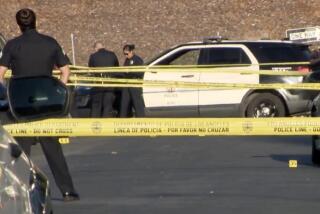They killed a child
- Share via
In the hurly-burly of an election week, it would have been easy to overlook the death of one little boy in a gang shooting. Such deaths are not infrequent enough in Los Angeles to be considered unusual; too often, children living in tough neighborhoods are caught in the crossfire of the youths and adults warring around them.
But that’s not what happened to 5-year-old Aaron Shannon Jr. Dressed in his Spider-Man costume for Halloween and showing it off to his grandfather and uncle in the family’s backyard, he was, by all appearances, intentionally gunned down Sunday. It is a crime that is heinous even by Los Angeles’ brutal gang warfare standards. Aaron’s family, police said, is not connected with gangs, but lives in a neighborhood where tensions between rival gangs are always simmering. Police suspect that the two shooters, who entered an alley adjacent to the family’s backyard, targeted the wrong house and the wrong family. But whether they were at the right house or the wrong house, there’s no getting around the fact that they aimed at and shot a child.
Immediately after the shooting, two intensive efforts began in the neighborhood of the 1000 block of East 84th Street. One, by intervention workers, was to calm the community and prevent violent retaliation for the boy’s death by rival gang members. The second — to find his killers — paid off when police arrested two suspects this week.
Until this homicide, recent news about gang violence in Los Angeles had been positive. Citywide, gang-related crime has been falling, and where the Summer Night Lights program was active, the reductions were particularly dramatic, with a 57% decrease in homicides. That program kept parks open after dark from July 4 to Labor Day; an audit found that residents made 710,000 visits to the program’s 24 sites and that free meals were served to 10,929 people.
One crucial component to combating gangs is changing the culture in the neighborhoods where they operate. That includes building a trusting relationship between residents and the police and encouraging a willingness to cooperate with investigations and prosecutions. The mayor’s gang czar, Guillermo Cespedes, says Summer Night Lights’ real success is not in statistics but in community buy-in. In Aaron’s case, the community rallied against the perpetrators, and even gang members cooperated with the investigation, police said, a sign of hope in an otherwise tragic situation.
The best programs cannot stop every random act of viciousness, and public safety is not only about catching criminals— it is about stitching together neighborhoods that will not tolerate gang warfare. That’s the work that continues.
More to Read
Sign up for Essential California
The most important California stories and recommendations in your inbox every morning.
You may occasionally receive promotional content from the Los Angeles Times.








